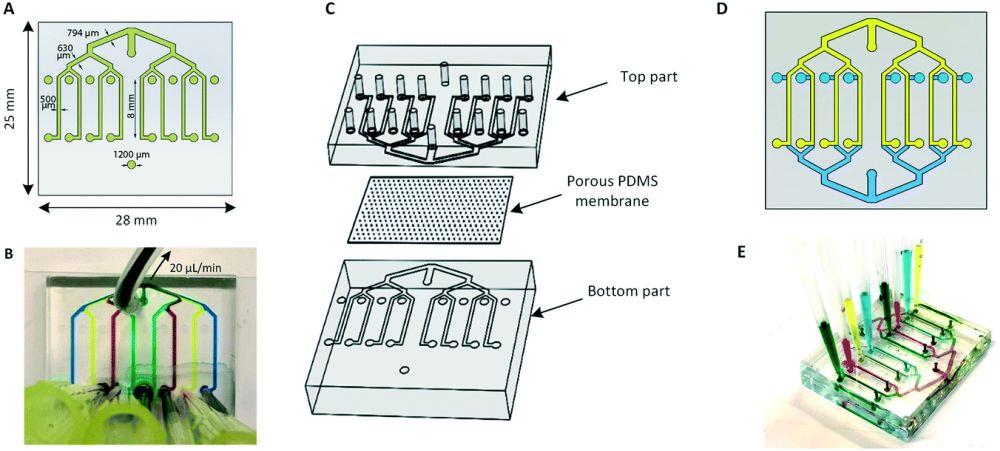
07 Aug Microfluidic device for high throughput and multiplex screening of the blood-brain barrier
The Blood-Brain Barrier (BBB) is a highly selective membrane that separates the blood flow from the bulk of the brain and the central nervous system. This membrane is semi-permeable and ensures that the brain maintains its functionality by blocking unwanted molecules and ions from entering the brain. This brain blood barrier often consists of an endothelial layer expressing high levels of tight junction proteins and a complex network of astrocytes and pericytes. Although this barrier protects the brain from the toxins and unwanted molecules and plays a role in brain homeostasis, it can resist therapeutic drugs from entering the brain thus creating an obstacle for cancer therapy too. Therefore, in vitro models capable of modelling the blood-brain barrier can be advantageous in developing new therapeutics that can penetrate the brain.
A multidisciplinary group of researchers from the University of Twente and the Leiden University Medical Center have now taken advantage of microfluidics to develop a Blood-Brain Barrier-on-a-chip device capable of multiplex studies. The proposed microfluidic chip consists of multiple parallel functional units that allow up to eight tests to be done simultaneously.
“We believe that our device can be used for the characterization of barrier tissues that allows better reproducibility and identical conditions, e.g. temperature, seeding density, and pH, within one single chip.”, the authors explained.
Design of the microfluidic blood-brain barrier chip
The PDMS microfluidic chip consists of two layers separated by a 2 µm PDMS membrane with through-hole pores. The proposed microfluidic device includes eight parallel microchannels designed such that they all have the same fluidic resistance. Therefore, each microchannel received the same amount of liquid from the inlet. At first, a COMSOL multiphysics simulation was done to observe the flow patterns inside the microfluidic device that confirmed the uniform distribution of the fluid in the channel. Cross-contamination caused by the diffusion of the particulates through the gap between the channels can lead to measurement errors. Calculation of the Peclet number guaranteed that there is no risk of cross-contamination in between the microfluidic channels.

Schematic of the blood-brain barrier microfluidic chip. Reproduced under a Creative Commons Attribution 3.0 Unported Licence.
For the blood-brain barrier experiments, one side of the device was lined with endothelial cells while the other side contained a co-culture of endothelial cells and human astrocytes. Phase-contrast microscopy confirmed monolayer formation and live-dead and mitochondrial staining ensured cell viability and metabolic activity, respectively. The formation of the junction between the layers was tested by immunostaining the endothelial cells. The permeability was tested by refusing the device with small (4 kDa) and large (20 kDa) fluorescent molecules. It was shown that there was a considerable difference between the permeability of the molecules in the absence and presence of the monolayer.
Read the original article: Multiplexed blood–brain barrier organ-on-chip

Pouriya Bayat
Pouriya is a microfluidic production engineer at uFluidix. He received his B.Sc. and M.A.Sc. both in Mechanical Engineering from Isfahan University of Technology and York University, respectively. During his master's studies, he had the chance to learn the foundations of microfluidic technology at ACUTE Lab where he focused on designing microfluidic platforms for cell washing and isolation. Upon graduation, he joined uFluidix to even further enjoy designing, manufacturing, and experimenting with microfluidic chips. In his free time, you might find him reading a psychology/philosophy/fantasy book while refilling his coffee every half an hour. Is there a must-read book in your mind, do not hesitate to hit him up with your to-read list.


